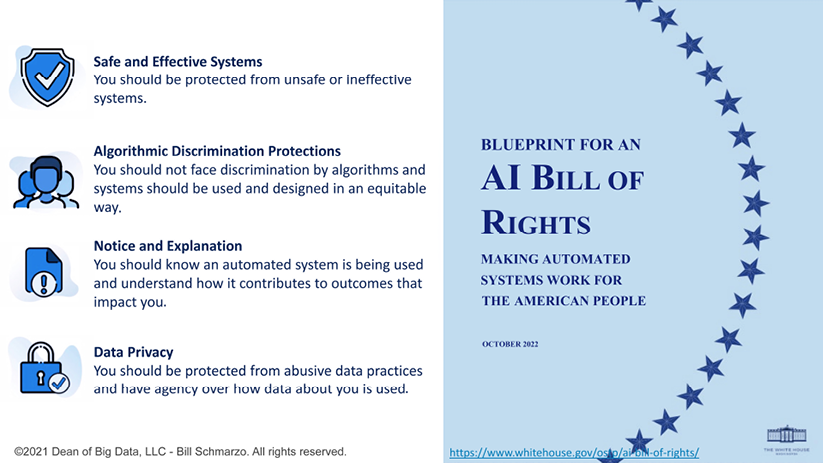Understanding AI
Okay, before we go any further, let’s establish a standard definition of AI.
An AI model is a set of algorithms that seek to optimize decisions and actions by mapping probabilistic outcomes to a utility value within a constantly changing environment…with minimal human intervention.
Let’s simplify the complexity and distill it into these key takeaways:
- Seeks to optimize its decisions and actions to achieve the desired outcomes as framed by user intent
- Interacts and engages within a constantly changing operational environment
- Evaluates input variables and metrics and their relative weights to assign a utility value to specific decisions and actions (AI utility function)
- Measures and quantifies the effectiveness of those decisions and actions (measuring the predicted result versus the actual result)
- Continuously learns and updates the weights and utility values in the AI utility function based on decision effectiveness feedback
…all of that with minimal human intervention.
We will dive deeper into AI and other advanced analytic algorithms in Chapters 3 and 4.
Dangers and risks of AI
The book 1984 by George Orwell, published in 1949, predicts a world of surveillance and citizen manipulation in society. In the book, the world’s leaders use propaganda and revisionist history to influence how people think, believe, and act. The book explores the consequences of totalitarianism, mass surveillance, repressive regimentation, propagandistic news, and the constant redefinition of acceptable societal behaviors and norms.
The world described in the book was modeled after Nazi Germany and Joseph Goebbels’ efforts to weaponize propaganda – the use of biased, misleading, and false information to promote a particular cause or point of view – to persuade everyday Germans to support a maniacal leader and his criminal and immoral view for the future of Germany.
But this isn’t just yesteryear’s challenge. In August 2021, Apple proposed to apply AI across the vast wealth of photos captured by their iPhones to detect child pornography[3].
Apple has a strong history of protecting user privacy. Twice, by the Justice Department in 2016 and the US Attorney General in 2019, Apple was asked to create a software patch that would break the iPhone’s privacy protections. And both times, Apple refused based on their beliefs that such an action would undermine the user privacy and trust that they have cultivated.
So, given Apple’s strong position on user privacy, Apple’s proposal to stop child pornography utilizing their users’ private data was surprising. Controlling child pornography is certainly a top social priority, but at what cost? The answer is not black and white.
Several user privacy questions arise, including:
- To what extent are individuals willing to sacrifice their personal privacy to combat this abhorrent behavior?
- To what extent do we have confidence in the organization (Apple, in this case) to limit the usage of this data solely for the purpose of combating child pornography?
- To what extent can we trust that the findings of the analysis will not fall into the hands of unethical players and be exploited for nefarious purposes?
- What are the social and individual consequences linked to the AI model’s false positives (erroneously accusing an innocent person of child pornography) and false negatives (failing to identify individuals involved in child pornography)?
These types of questions, choices, and decisions impact everyone. And to be adequately prepared for these types of conversations, we must educate everyone on the basics of AI and data literacy.
AI Bill of Rights
The White House Office of Science and Technology Policy (OSTP) released a document called Blueprint for an AI Bill of Rights[4] on October 4, 2022, outlining five principles and related practices to help guide the design, use, and deployment of AI technologies to safeguard the rights of the American public in light of the increasing use and implementation of AI technologies.
To quote the preface of the extensive paper:
“Among the great challenges posed to democracy today is the use of technology, data, and automated systems in ways that threaten the rights of the American public. Too often, these tools are used to limit our opportunities and prevent our access to critical resources or services. These problems are well documented. In America and around the world, systems supposed to help with patient care have proven unsafe, ineffective, or biased. Algorithms used in hiring and credit decisions have been found to reflect and reproduce existing unwanted inequities or embed new harmful bias and discrimination. Unchecked social media data collection has been used to threaten people’s opportunities, undermine their privacy, or pervasively track their activity—often without their knowledge or consent.”
The paper articulates your rights when interacting with systems or applications that use AI (Figure 1.1):
- You should be protected from unsafe or ineffective systems.
- You should not face discrimination by algorithms; systems should be used and designed equitably.
- You should be protected from abusive data practices via built-in protections and have agency over how data about you is used.
- You should know that an automated system is being used and understand how and why it contributes to outcomes that impact you.

Figure 1.1: AI Bill of Rights blueprint
The AI Bill of Rights is a good start in increasing awareness of the challenges associated with AI. But in and of itself, the AI Bill of Rights is insufficient because it does not provide a pragmatic set of actions to guide an organization’s design, development, deployment, and management of their AI models. The next step should be to facilitate collaboration and adoption across representative business, education, social, and government organizations and agencies to identify the measures against which the AI Bill of Rights will be measured. This collaboration should also define the AI-related laws and regulations – with the appropriate incentives and penalties – to enforce adherence to this AI Bill of Rights.

